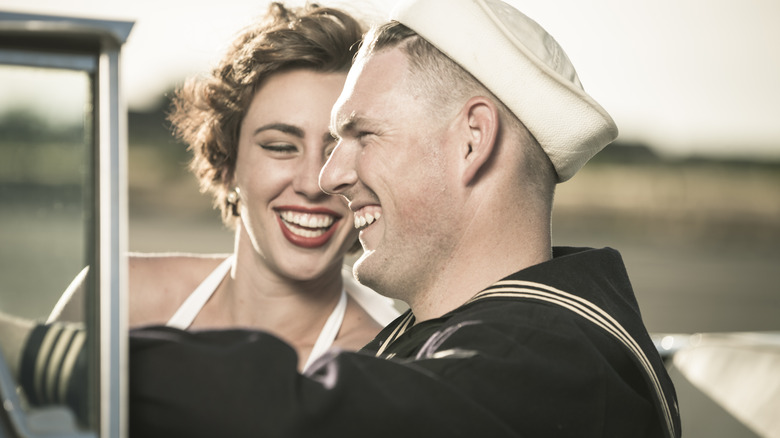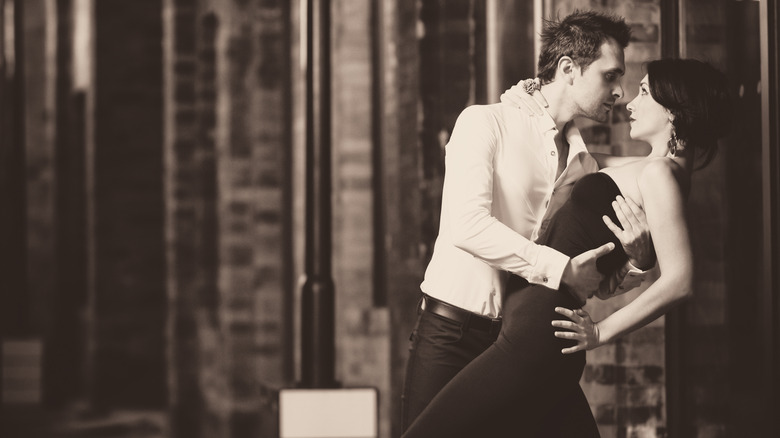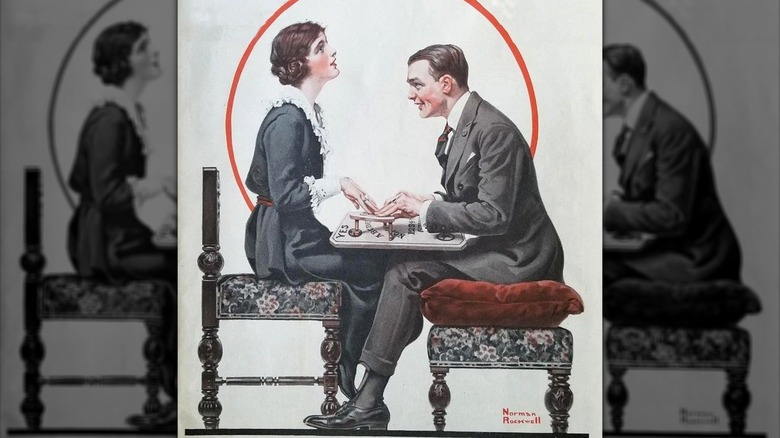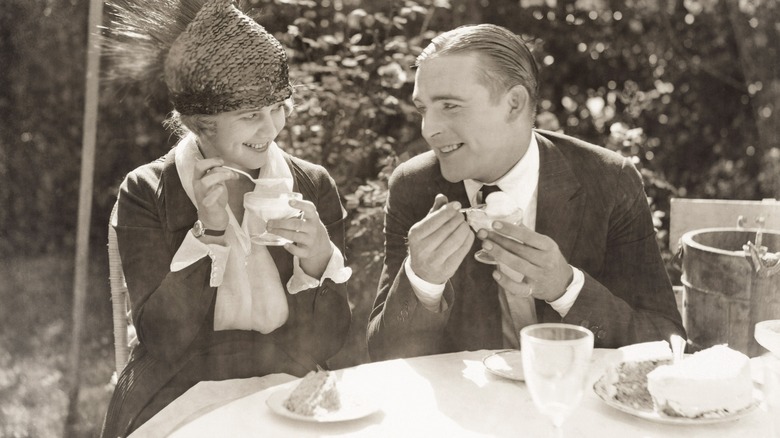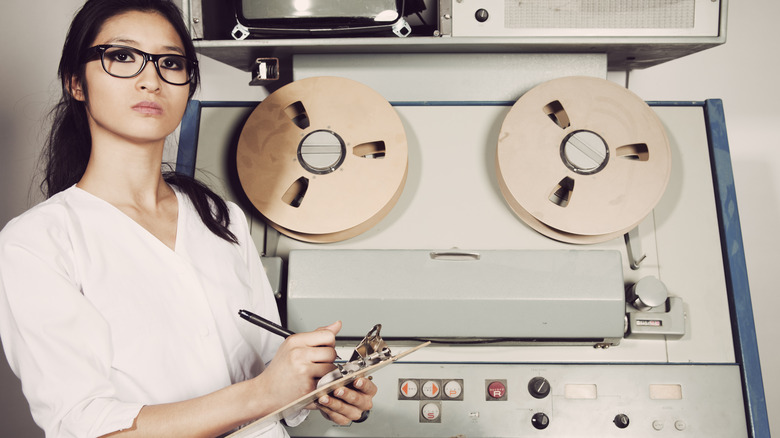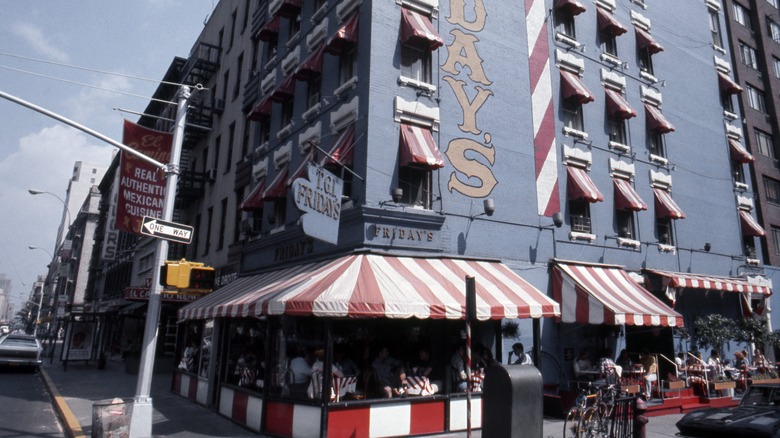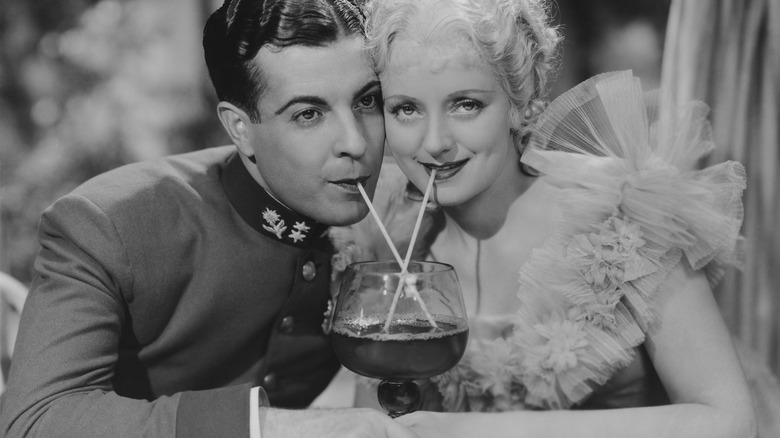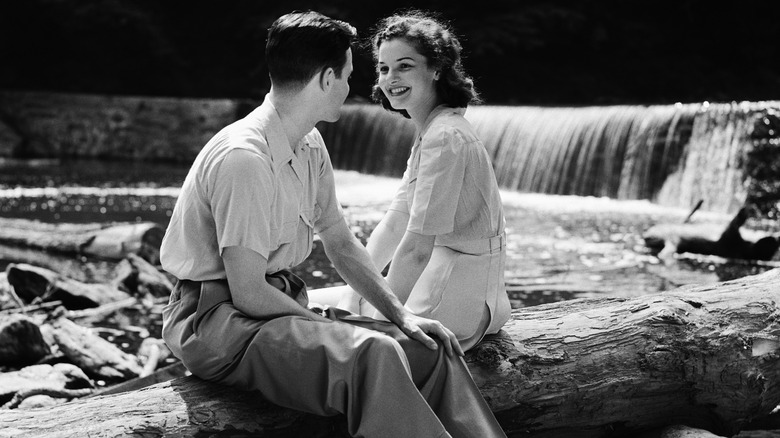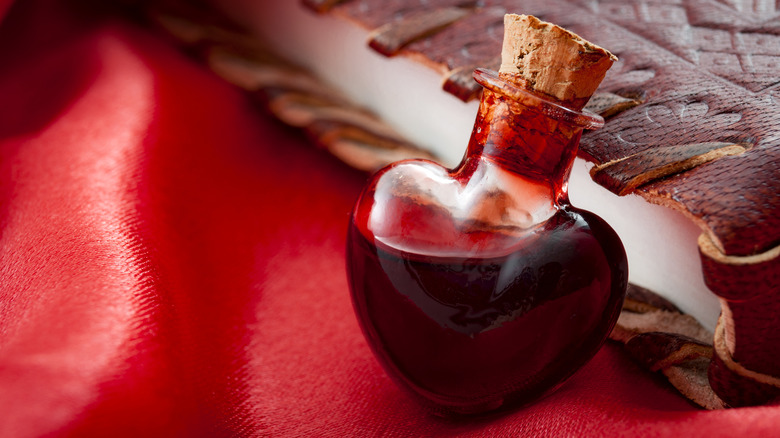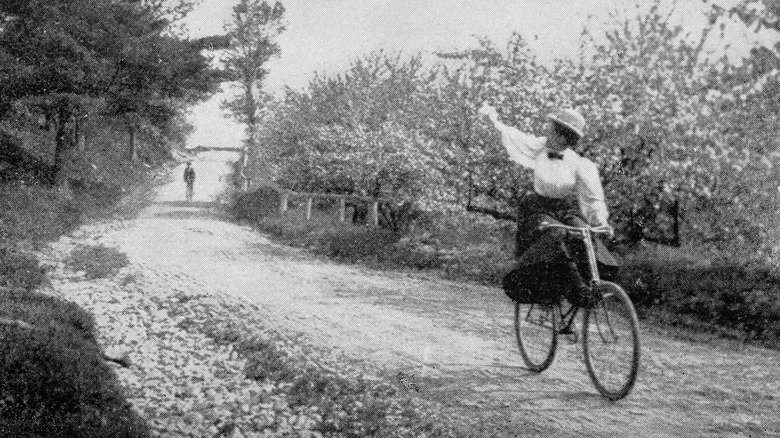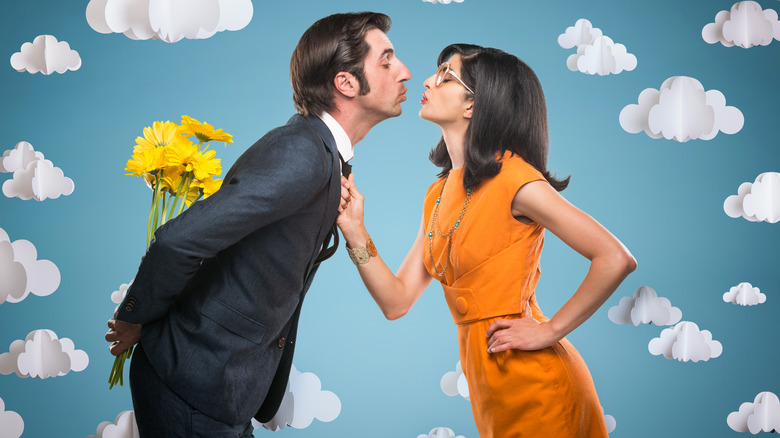Strange Details About Dating In The Past
Here's Fun Fact No. 1: Dating didn't exist until the late 19th century. But surely, one might protest, people had to be getting together before then, so what gives? Well, here's the deal, as explained by historians Allan Carlson and Beth Bailey in the audio report "Wandering Toward the Altar: The Decline of American Courtship (via Boundless). In a nutshell, early couples participated in courtship, which is a more formal way of deciding whether or not the other person is marriage material. Partnerships were often arranged, reasons were often based on financial concerns instead of romantic motivations, and meetings took place in a family-chaperoned, at-home sort of situation.
Dating, on the other hand, is the practice of going out in the big, wide, and more importantly, unsupervised world to meet up with the person of an individual's choosing to have some fun. That's not to say courtship is non-existent in our modern world, but it is different — and that's an important distinction.
Things were starting to shift toward romantic dating during the Victorian era, inspired by none other than Queen Victoria herself. She set an example of marrying with love in mind — famously mourning Prince Albert for the rest of her days — but there were still chaperones in play for many young couples. That went out the door with World War I, and honestly, that's just the tip of the iceberg. So, let's talk dating, how it became what it is today, and the weird, weird things that happened along the way.
Dating is a modern thing... for a surprising reason
Back in ye olde times, it was financial security that was among the chief concerns when it came to picking a mate, and in fact, the term "dating" wasn't even coined until 1896. That's when an American journalist named George Ade overheard a coworker lament that a girl he fancied was having her calendar filled by others — all her "dates" were taken. So surely, we've moved on from economic-based reasons for companionship and marriage, right? Not quite.
Yale Ph.D. candidate Moira Weigel did a deep dive into the development of dating, and according to what she told The Atlantic, it was still rooted in finances. Weigel said that her findings suggest dating in a more modern sense only happened when women started working outside the home. "As women entered the workforce and hit the city streets, they gained new freedom to mix with men," she explained. "Think how many men a woman who worked as a waitress in a busy restaurant might have met in a single day. It must have been thrilling!" In other words, women were finally free to meet men on their own... in a socially acceptable way.
Dating initially belonged solely to the working classes, and the long-held belief that men should pick up the tab came from early wage discrepancies. Weigel says that in some cases, going on a date was the only way some women could get a hot meal. Choosing a partner, it seems, remained an economic consideration.
Ouija boards were once popular on dates
Ask anyone what they think of Ouija boards, and they're bound to have a pretty definite answer. Still, regardless of whether they're seen as a diabolical way of summoning demonic spawn or a shameless money grab, Ouija boards have a fascinating place in the history of dating.
It didn't start that way, though. The death-obsessed people of the Victorian era were fascinated with spiritualism, and truth be told, they had a good reason to be obsessed — particularly Americans. Pretty much everyone knew someone who had died in the Civil War, and the prospect of being able to contact them one last time was undeniably alluring. The Kennard Novelty Company soon realized that there was a market for this sort of thing, and mass-producing Ouija boards made them widely available.
By the time the Jazz Age rolled around, they weren't just being used to contact the great beyond — they were being used by couples to get up-close-and-personal in a socially acceptable way. It was such a popular dating activity that it inspired one of Norman Rockwell's iconic Saturday Evening Post covers (pictured). It depicts a young couple with a Ouija board between them, more interested in their touching fingers than anything the board might say. It was based on a real-life couple he saw at a 1919 party at a dance hall, and made the magazine's cover the following year.
Women on dates once feared being arrested for sex work
Today, dating seems so perfectly ordinary that seeing a couple out on a date isn't worth a second glance. In the 1910s, though, it was seen as so outrageous that it could — and did — land women in jail. Why? According to what Moira Weigel discovered in researching her book "Labor of Love: The Invention of Dating," women who dated were seen by some as a type of sex worker, exchanging goods for — ahem — services.
These early dating women were even given a name: Charity Girls. Weigel says (via the New York Post) they were called that because they didn't accept money, and she wrote that this new dating thing had such an impact on New York City's cultural landscape that sex workers "complained that Charity Girls were putting them out of business." Weigel explained (to The Nation) that it wasn't entirely out of left field, saying, "Dating is this form of courtship that has market dynamics."
It wasn't just the older generation looking down at the younger, either, and Wiegel says that the powers-that-be — including John D. Rockefeller Jr. — got involved and financed investigations dedicated to curbing the dating trend. She cited one case of many, that of a woman who had been institutionalized in the Bedford Reformatory for dating: "[She] told her jailers again and again that she had 'never taken money from men.' Instead, men took her 'to Coney Island to dances and Picture Shows.'"
Computers have been helping out for a shockingly long time
Most people think computer-assisted dating really got going in the mid-1990s, but the truth is much stranger: Computer dating had already been going on for decades. Way back in 1957, George W. Crane set up the Scientific Marriage Foundation, and it was every bit as epic as the name suggests.
It was also pretty straightforward. Singles would order some forms, fill them out, and send them in to the company, which would use an IBM sorting machine to pair up likely matches. Crane said it was pretty successful, too, and it was just a few years later that a British businesswoman named Joan Ball went from working in a matchmaking bureau to opening her own, where she made matches with the help of a computer.
Ball's version was the St. James Computer Dating Service, and she sort of flipped things on their figurative head when she decided to use a computer to pair up people based on their answers about what they didn't want in a partner and a relationship, instead of what they did want. She was ultimately forced to sell to another computer dating service called Dateline, which was started in 1966 with some inspiration from a Harvard-based dating service. Even in those early days, there were people outraged at the idea: One columnist from The Guardian wrote (via The Economist) that "no computer — however flashy its innards — can introduce you to anyone whose details [aren't] already in its maw."
Looking to meet a single lady? TGI Friday's was once the place
Today, TGI Friday's is the place to go for cheap drinks and cheaper appetizers. But there's a fascinating bit of dating history here: TGI Friday's originated as one man's plan to hook up with single ladies, and was so successful it helped usher in the free-love era of the late 1960s. How? By providing a blueprint for public places where men and women could meet. It was a revolutionary idea because at the time, mingling with a drink in hand was mostly done at private cocktail parties — a holdover of the Prohibition era.
In 1965, New York City-based salesman Alan Stillman stumbled into the chance to buy an Upper East Side bar (pictured). He told Business Insider, "My business plan was to meet a lot of women." He borrowed some cash, cleaned the place up, and redecorated with an eye toward making it more welcoming to his desired clientele: women.
The bar was so popular that it spawned a ton of copycats. Stillman said, "It became more similar to what a mosh pit is. It was so crowded that you didn't have to walk up to anybody to get a name or a telephone number. You bumped into them." It was a huge deal: Until the establishment of places like TGI Friday's, bars didn't usually attract a co-ed crowd. So if you appreciate being able to go out and mingle while you enjoy a drink or two, thank Stillman and TGI Friday's.
Date-free? In the 1930s, women could rent a man
While the 1930s saw something of a revolution in terms of what women could do — including living on their own and finding work in an office or shop — there were still limits. For starters, women who were hoping to hit the town and head to some of New York City's biggest and best nightclubs were out of luck if they wanted to go solo or with a group of other women.
Ted Peckham had a solution. He realized there was a massive market targeting women who were visiting the city and had no local connections, and founded his Guide Escort Service. It was precisely that, and employed only the most gentlemanly of gentlemen to serve as a hired date-for-the-evening. That's not an exaggeration: Peckham required a resume that included things like an Ivy League education or connections to royalty, and a steady job. Given that the Great Depression was in full swing, that was no small ask.
Writing of his business plan in a memoir, Peckham explained (via The New Yorker) "We did not permit hanky-panky, and our boys could hold coats but never hands. ... I am not so foolish, however, as to exclude sex completely, for I know it registers itself in everything we do." That said, Peckham required all dates to meet the same standards, regardless of how they ended: "[Escorts] would have to remain the perfect, cavalier, attractive, entertaining, and ingratiating throughout an entire evening, even if he didn't like the woman who had hired him."
Speed dating was invented by a Jewish rabbi
Surely, the concept of speed dating was the brainchild of an enterprising nightclub owner looking for a gimmick to lure in customers. Or perhaps it was a bar owner, trying to update a boring old trivia night. Not exactly. The truth is much stranger: Speed dating started with a Jewish rabbi named Yaacov Deyo.
The Los Angeles-based Deyo wanted to come up with a way to encourage connections between strangers in a time that didn't really encourage those connections to be made independently — the heady, nearly ancient days of 1998. Inspired by the idea of a gameshow-like setting, Deyo initially set a 10-minute time limit for chatting with strangers, and signaled switches with a traditional noisemaker called a gragger. It was a massive hit, and spread across the country before he could copyright it.
In the end, he was all right with that. "In Judaism, there's a concept of zechus," he told The New York Times. "[It's] the merit that is created by good action. To see your actions unfold in a good way makes for a happier existence, and I'm a happy guy." That said, does it work? Perhaps not as well as more recent methods like online dating, but it's still a heck of a lot of fun.
Post-war teens could learn from mental hygiene films
World War II changed a lot, including the social landscape of all the countries involved. Teenagers found themselves forced to navigate a world with a whole new set of challenges, morals, and obligations, but they had something to guide them. Short movies inspired by World War II propaganda films were called "mental hygiene films," and covered everything a young person would need to know about. That included dating.
Let's take a specific example (via History). "Dating Do's and Don'ts" was released in 1949, and it started with a young man finding a ticket to a carnival that specified it was for one couple. He's given instructions on how to choose a date, how to ask a girl out, and how to behave on the date once he's there. And saying goodnight? They suggested the proper way to do that, too, and it definitely didn't include being too pushy or too standoffish.
Ken Smith is the author of "Mental Hygiene: Better Living Through Classroom Films, 1945-1970." In a piece for The New York Times, he wrote that thousands of films were made, millions watched them, and they're interesting artifacts that depict life not as it was, but as adults wanted teens to live it. "The students were supposed to believe that what they saw was real and to adopt the film's point of view," he explained, calling them "ham-fisted, dogmatic, frequently brutal... films [that] preached the joys of domesticity and uniformity." Sounds fun!
Need some extra help? Try a love potion
First, a disclaimer: Do not actually try any of these very real love potions that have been presented to would-be paramours during various stages of courtship and dating... for reasons that will quickly become clear. The idea of using love potions to improve one's chances with a beloved, betrothed, or other object of affection goes back a long time, at least as far as ancient Greece and Rome. Let's talk about some of the more bizarre options that are out there... and be thankful we're not living in the medieval era.
That's when so-called "sweaty cakes" became popular, and yes, it's exactly what it sounds like: The target of someone's affections would be presented with a cake that had been made with ingredients like sweat and blood, so that's a thing. Skulls and bones have also been common ingredients in love potions, and some cultures are known to get even more specific.
Charles Lindholm is an anthropologist who's studied this sort of thing, and this one's best described in his own words (via JSTOR): "Among the Yusufzai Pukhtun of Swat in Northern Pakistan, the most efficacious love magic is the water that has been used to bathe the body of a dead leatherworker." There are scores of other ingredients, too, ranging from the perfectly ordinary — like coconut oil — to the tears of a female dolphin, and datura, a plant that is most definitely poisonous.
Bicycles changed the way dating worked
The late 19th century was a time when relationships were shifting away from courtship into a sort of dating that's more familiar to modern eyes, and one of the reasons it happened is pretty strange. By the 1890s, many church and community leaders were denouncing what they saw as a major threat to morality, decency, and — presumably — all that was good and sacred in the world. That was the bicycle, which skyrocketed in popularity once the ridiculously difficult-to-ride penny farthing gave way to the sort of bicycles still ridden today.
Bicycles are, of course, designed to be ridden by a single person, and that included women like Beatrice Grimshaw. She was known as one of the Victorian era's so-called "revolting daughters," and wrote (via Counter Currents), "I bought a bicycle, with difficulty. I rode it unchaperoned, miles and miles beyond the limits possible to the soberly trotting horses. The world opened before me. And as soon as my twenty-first birthday dawned, I went away from home, to see what the world might give to daughters who revolted."
And there's a key concept in there. The getting-to-know-you phase of courtship had typically been done under the watchful eyes of chaperones, but with the dawn of the bicycle, women could go off on their own. Instead of relying on fathers and brothers, they could — gasp! — step into a pair of pantaloons and ride off into the sunset... and a meeting with a paramour. And then, they didn't look back.
There's a weird connection between personality and dating
So here's a weird thing: Everyone knows what "personality" involves right? Not exactly, and according to Dr. Krishnamurthy Kavirayani of Bharatpur's College of Medical Sciences, "there is no generally agreed-upon definition of personality." There are plenty of suggestions, though, with many people thinking of personality in terms of a person's thought patterns, behaviors, feelings, and how they act in relationships. Sigmund Freud is widely credited with developing basic ideas surrounding personality, but until the advent of modern dating, "personality" was mostly a negative thing.
That's according to dating historian, researcher, and author Moira Weigel. In her book "Labor of Love: The Invention of Dating," she wrote (via the New York Post) that dating overhauled thinking about personality. Previous conversations focused on "personality disorders," Weigel wrote. "Starting around 1920, however, experts began to grant that healthy individuals had personalities, too. ... Personality was like 'painting' — a way a woman could make herself up in order to appeal to men."
The importance people started to put on personality was perhaps no better illustrated than the concept of the "It Girl." The highly desired "it" was described in various ways, and it had to do with allure, charisma, and the ability to showcase it. In a 1926 article for Cosmopolitan, Elinor Glyn described it like this: "With 'It,' you win all men if you are a woman — and all women if you are a man."
